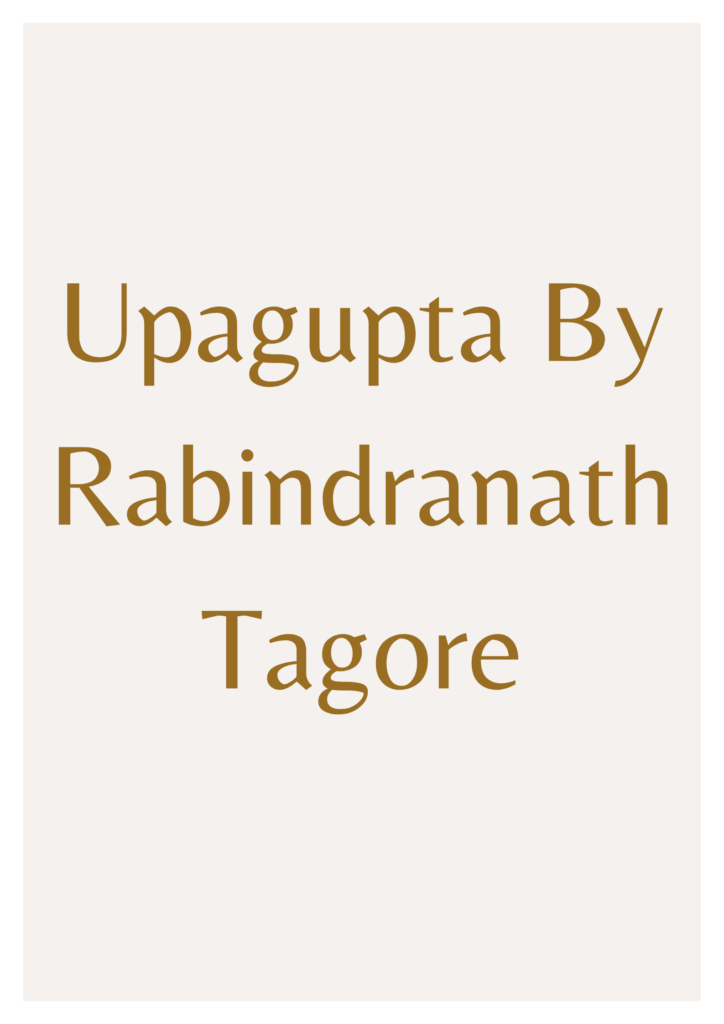Explore the full English summary of Upagupta by Rabindranath Tagore, a timeless poem that reflects themes of love, compassion, and the passage of time with deep emotional insight.
Upagupta Summary By Rabindranath Tagore

Summary of Upagupta Poem By Rabindranath Tagore
Introduction
Rabindranath Tagore’s poem “Upagupt” is an excellent example of his human sensibility, philosophical outlook and compassionate creativity. This poem was first published in 1914 and its original Bengali poem was titled “Abhisar”. Later it was translated into Hindi and became famous with the title Upagupt.
This is a symbolic narrative poem, which teaches readers the lessons of love, sacrifice, compassion, restraint and the transience of life through the events of two different times.
Background of the poem
Location: Mathura city (which is also considered to be the city of Lord Krishna)
Main characters
Upagupt: A Buddhist monk, a symbol of restraint and compassion
Vasavadatta: A beautiful courtesan, who is a symbol of youth and pleasure
First scene – Spring night, first meeting
The poem begins with a fragrant night of spring. The whole atmosphere is charming – the moonlight is scattered, there is a slight coolness in the air and the fragrance of flowers is spread all around. This is a time when nature itself seems to call for love.
That same night, a young sadhu named Upagupta is walking quietly in a street of Mathura. He rests on the ground near a wall. At that time, Vasavadatta, the famous beautiful dancer of the city, passes by. She is wrapped in her makeup and beauty – there is confidence in her walk and charm in her eyes.
As soon as she sees Upagupta lying on the ground, she stops. She is impressed by his sadhu-like attire, calm face and self-controlled gaze. She urges him – “You come with me…”
This invitation is not that of a lover, but of a woman who knows that her beauty can attract men. But Upagupta replies very calmly –
“No, not now. I will definitely come to you when the time comes.”
Vasavadatta is surprised to hear this answer. This is the first experience for her that a man can refuse her without being impressed by her beauty.
Second Scene – Rainy Night, Second Meeting
Time passes. Seasons change, so do the conditions of life. It is now the rainy season. Instead of a moonlit night, it is now a dark, stormy, rainy night. The atmosphere is now full of fear and sadness.
Outside the city, where there is dirt and darkness, a woman is lying under a tree, moaning. She is none other than Vasavadatta. Her condition is no longer the same. She has been expelled from the city for some reason – now she is a neglected, sick and suffering woman. Her body is covered with boils, her face has withered, and her self-confidence has been shattered.
At that moment Upagupta arrives there. He sits beside her without any disgust. He applies ointment on her wounds, gives her water to drink and takes care of her like a mother.
Vasavadatta asks in a groaning voice –
“Who are you, who has come to me in this dark night?”
Upagupta smiles and replies –
“I am the same person… who one night rejected your invitation saying – ‘Not now’. Now the time has come. That is why I am here.”
Symbols and deep meanings of the poem
1. Symbolism of time
The soul of the poem is “time”. Upagupta’s statement – “Not now, when the time comes”, shows that there is a right time for every work.
Youth and beauty are momentary, but compassion and service are beyond time.
2. Upagupta – the epitome of sacrifice and compassion
The person who keeps distance at the time of attachment, but supports in pain – is a true human being.
Upagupta is the symbol of Buddhist philosophy – compassion, restraint, liberation from illusion.
3. Vasavadatta — The journey of human life
The journey from youth to decrepitude is shown through Vasavadatta.
She was once revered by the society, now she is despised by the same society.
4. Pure form of love
Upgupta’s love is not full of attraction, but of service.
This is love without lust, a symbol of compassion and affection.
Style and language of the poem
Rabindranath Tagore’s language is extremely sensitive. There is music in the words, philosophy in the symbols, and the visualization is such that the reader can see the scene with his eyes. The description of the two seasons in the poem — spring and rain — are not just changes in nature, but are symbols of the inner journey of the characters.
Spring = attraction, culmination of life
Rain = loneliness, purification, change
Moral message (learning)
True humanity is that which serves others without any selfishness.
Love is not just physical attraction, it is also compassion and dedication.
Time changes everything – that is why humility is necessary in life.
Supporting others in their pain is the greatest religion.
Importance of the poem in today’s society
“Upagupt” gives a deep message in today’s materialistic society – where relationships are formed for attraction, fame and profit, characters like Upagupt are like a ray of light. This poem teaches us that true love is that which supports in adversity, and a human being is one who stands for service.
Conclusion
“Upagupt” is not just a poem, but a deep philosophy of life. Rabindranath Tagore not only presented human values through a simple story, but through this poem he told that values like love, service and compassion always remain immortal. This poem inspires us to introspect – can we also become selfless like Upagupt?